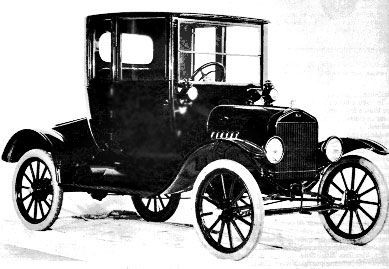 |
Feature Story
HISTORY: MODEL A FORD IS 70 YEARS OLD
by Bob Hagin
May 15, 1998
The Model A Ford is 70 years old this year and its existence marked a pivotal point in my own life. My earliest recollection is of waking up in the back seat of my father's Model A Ford Tudor (that was the official Ford name for the two-door sedan) with my sister Barbara at the historic Oakland Oaks ballpark in Emeryville, Calif. I was tired and cranky, but my sister reassured me that we'd be home soon. I was probably around two years old at the time.
Like most other Americans then, Dad was intrigued by the automobile in general and Fords in particular. He no doubt owned other cars earlier (possibly a Model T Ford or two) but the Model A was his idol until he progressed to a '36 Ford V8 - also a Tudor.
What my dad wasn't aware of was what a tumultuous gestation and birth the Model A had to endure. This analogy to the birth process is apropos because it was just eight months between the time in July of 1926 when Henry Ford decided to replace his Model T, and the March 27, 1927 appearance of the first Model A rolling prototype. Today a changeover of that magnitude would take several years to go from drawing board to reality. The changeover from the Model T to the Model A was almost as radical as a changeover from gasoline powered vehicles to electric cars would be today.
Ford first introduced his Model T 17 years before he made the decision to replace it, and altering the mind-set of "The Old Man" took a concentrated and sometimes surreptitious effort on the part of those closest to him. He was aging (Ford had been born two years before the end of our Civil War), cantankerous (he periodically fired and rehired family members who worked for him), prejudiced (he started his own newspaper to attack ethnic and political groups that displeased him) and anti-labor (his "security" lieutenants orchestrated beatings of union leaders by Ford "goon" squads). But whatever else he might have been, he was in charge. The Ford Motor Company was totally family-owned and Henry Ford was head of the family. And since he believed that his Model T was as much car as the average American needed, it took irresistible forces to make him change his mind.
Those forces eventually came from an area outside of Ford's control. While he felt that the Model T was what the American public needed, the American public didn't agree. In the low-priced car market, Chevrolet was closing in on Ford's sales leadership because of factory slowdowns, and Chrysler was ready to spring into the fray with its entry-level 1928 Plymouth. And while the new rival from Chrysler featured hydraulically- actuated brakes on all four wheels, Ford's Model T retained Henry's dogmatic concept that lever-operated brakes on just the rear wheels was sufficient. This factor alone may have been the determining factor for the change to the Model A, since several states were considering banning the Model T as too dangerous for "modern" traffic conditions. What was OK in 1909 was outmoded 19 years later. Changes at Ford were needed.
When those changes came in the form of the Model A, they were extensive. Where the Model T transmission was a two-speed, pedal- operated planetary system, its successor utilized a three-speed, lever-operated sliding gear unit complete with a clutch. The ignition on the Model T used a magneto operating off the flywheel, while the Model A used a Kettering-type battery-and-coil system. Four wheel brakes were also featured on the new car, as was a water pump to circulate coolant through the engine. Previous Ford engines depended on the thermosyphon phenomena to circulate their coolant.
The need for one modern safety feature in his new car was demonstrated very pointedly to Henry Ford during a preproduction road test. Harold Hicks, a Ford powertrain engineer who had been instrumental in improving the embryonic Model A engine, crashed a test car and was pitched through the plate glass windshield. Hicks sustained heavy injuries to one arm, and as a result of this, the Model A Ford carried safety glass from the day it was offered to the public.
One safety problem that was known to Ford engineers but nonetheless made it into its production was the location of the 10 gallon gas tank. It was, in actuality, the cowl of the car, and thus located directly above the feet and legs of the driver and front seat passenger. A dangerous location, but not as much so as its immediate ancestor. In the case of the Model T, the driver sat on the gas tank.
When Henry Ford decided to stop production of his Model T, the development of its replacement hadn't been completed, much less the conversions necessary to mass-produce the new car. Aside from the production of replacement parts (and new engines were built at the rate of 12,000 per day), Ford plants around the world were shut down and idled. The conversion of Ford tooling, production and supply lines, worker training and the myriad other changes that were needed must have been staggering. There were 36 Ford assembly plants in North America, as well as a dozen others around the world and they all had to be changed over at once. That Ford was able to pull it off speaks well of the company's determination - and luck. In all, the cast was some $250 million. Finally on December 2, 1927, the "modern" Ford was offered for sale to the public. During its life span of three years, 3.25 million Model A Fords were produced and hundreds of thousands of them survive today.
And I hope my dad's old Tudor in which my sister and I shared that back seat 63 years ago is one of them.


